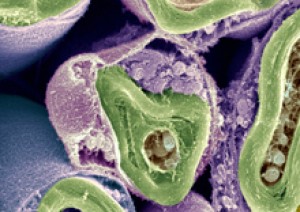Technique Selectively Represses Immune System
Technique Selectively Represses Immune System
Researchers devised a way to successfully treat symptoms resembling multiple sclerosis in a mouse model. With further development, the technique might be used to treat multiple sclerosis and other autoimmune disorders.

Myelin (green) encases and protects nerve fibers (brown). A new technique prevents the immune system from attacking myelin in a mouse model of multiple sclerosis. / Credit: Dr David Furness, Wellcome Images. All rights reserved by Wellcome Images.
Multiple sclerosis is an autoimmune disease—a type of disease in which the immune system mistakenly attacks the body’s own tissues. In multiple sclerosis, immune system T cells attack myelin, the insulating material that encases nerve fibers. Resulting nerve damage in the brain and spinal cord can cause muscle weakness, loss of vision, numbness or tingling, and difficulty with coordination and balance. It can also lead to paralysis.
Current treatments for autoimmune disorders involve the use of immunosuppressant drugs. These work by tamping down immune system activity. However, they can also leave patients susceptible to infections and increase their risk of cancer. Drs. Stephen Miller and Lonnie Shea at Northwestern University teamed up with researchers at the University of Sydney and the Myelin Repair Foundation in California to come up with a more targeted approach. They aimed to repress only the part of the immune system that causes autoimmune disorders while leaving the rest of the system intact.
Their new approach takes advantage of a natural safeguard used by the body to deactivate T cells that have the potential to attack the body’s healthy tissues. Apoptotic, or dying, cells release chemicals that attract immune system cells called macrophages. Macrophages gobble up the dying cells and deliver them to the spleen, where they present self-antigens—tiny portions of proteins from the dying cells—to a pool of T cells. To ensure that T cells don’t attack the body’s own tissues, the macrophages initiate the repression of any T cells that bind to the self-antigens.
In previous work, Miller’s group was able to couple specific self-antigens such as myelin to apoptotic cells to tap into this natural mechanism and suppress T cells that would normally attack the body’s own tissue. However, using apoptotic cells as a vehicle proved to be a costly, difficult and time-consuming procedure.
In the new study, the team linked myelin antigens to microscopic, biodegradable particles in the hope that these would be similarly taken up by circulating macrophages. Their work was partly supported by NIH’s National Institute of Biomedical Imaging and Bioengineering (NIBIB) and National Institute of Neurological Disorders and Stroke (NINDS). The study appeared online on November 18, 2012, in Nature Biotechnology.
The myelin-bound particles proved to be just as good as apoptotic cells, if not better, at inducing T-cell tolerance in a mouse model of multiple sclerosis. The particles both prevented symptoms and slowed their progression when injected at first detection of disease symptoms.
The team is hoping to begin phase I clinical trials in the near future. The material that makes up the particles has already been approved by the U.S. Food and Drug Administration for other uses. The researchers are also exploring the approach to treat other autoimmune diseases such as type 1 diabetes and food allergies.
“I think we’ve come up with a very potent way to induce tolerance that can be easily translated into clinical practice,” Miller says. “We’re doing everything we can now to take this forward.”
###
* The above story is reprinted from materials provided by National Institutes of Health (NIH)
** The National Institutes of Health (NIH) , a part of the U.S. Department of Health and Human Services, is the nation’s medical research agency—making important discoveries that improve health and save lives. The National Institutes of Health is made up of 27 different components called Institutes and Centers. Each has its own specific research agenda. All but three of these components receive their funding directly from Congress, and administrate their own budgets.



















